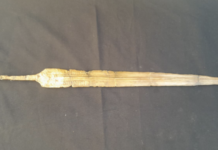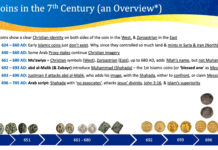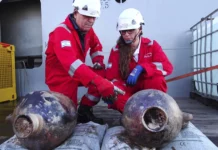By Brian Nixon
There are few events in a person’s life where one can say that they have changed a society’s understanding of history. For Dr. Steven Collins of Trinity Southwest University in Albuquerque, this just may be the case.
 |
|
Dr. Steven Collins monitoring the dig |
Upon his recent return from the Tall el-Hammam dig in Jordan, Dr. Collins was full of fascinating facts and possible historic findings.
But before I get into his recent finds, allow me to review what occurred during last year’s dig.
In my article “Sodom Found?” I wrote, “According to Collins, ‘The traditional “Southern Theory” site of Sodom does not have the geographical parallels described in the [biblical] text. Namely: 1. One can see the whole area from the hills above Jericho (Bethel/Ai), 2. It must be a well-watered place (described “like Egypt”), 3. It has a river running through it (the Jordan), and 4. It must follow the travel route of Lot” (who went to the other side of the Jordan, eastward, away from Jericho.)'”
What does all this mean? Simple: The traditional sites attributed as Sodom may be incorrect.
 |
|
The immediate vicinity of Tall el-Hammam (yellow) 14 KM NE of the Dead Sea |
With this, Dr. Collins and his team began digging at a new site, Tall el-Hammam, which corresponded to several factors. Dr. Collins summarized the end result: “To start with, the Tall el-Hammam site has twenty-five geographical indicators that align with the description in Genesis. Compare this with something well known-like Jerusalem-that has only sixteen. Other sites have only five or six. So this site has a greater number of indicators than any other Old Testament site. That is truly amazing.
“Second, our findings-pottery, architecture, and destruction layers-fit the timeframe profile. Meaning we should expect to find items like what we are finding from the Middle Bronze Age. This is exactly what we are uncovering.
“Lastly, we have secured internationally recognized experts to review our findings. One such person is Dr. Robert Mullins; then there are our colleagues from the Department of Antiquities in Jordan. Dr. Mullins is an expert in Bronze Age pottery, and there are many others as well. My ceramic expertise also covers the Bronze Age. Their conclusions on the matter reflect that our findings are correct. Once again, this is incredible.”
 |
|
EB3/1BA doorway with door socket stone |
“Though we are still digging and uncovering a plethora of material and artifacts, and much research still needs to be conducted, I feel that the evidence for this being the ancient city of Sodom is increasing by the day.”
The bottom line was that the findings of Dr. Collins’ team in Jordan were producing great results-all pointing to the city of Sodom.
Now let’s fast-forward a year.
As I met Dr. Collins at Solomon’s Porch Café (aptly named title for our meeting) in Albuquerque, I could tell something exciting was afoot.
We sat down with our tea and coffee and began to chat.
I started by asking some simple questions: “How long was this particular dig?”
“The dig was from December 6, 2010 through January 28, 2011,” Dr. Collins replied.
Did you bring a team?
“Yes, 120 of us split between Jordanian workers and staff, Trinity Southwest University staff, and volunteers from around the world.”
Was the location in the exact place as last year? I asked.
“Yes. We call this the Premier location. What made this dig exciting, however,” Dr. Collin’s shifted in his chair with enthusiasm as he continued, “Is that the Director General of Antiquities spent a good deal of time with us.”
“You see, in Jordan, the news of this find has created large interest. As a matter of fact, one of the leading archaeologists from Jordan stated: ‘This is perhaps the most important archaeological discovery of the modern era.'”
“What the Jordanian’s-and many others-are beginning to see is the mounting evidence for Sodom,” Dr. Collins concluded.
Beyond last year’s discoveries, what new evidence are you referring to? I enthusiastically wondered aloud.
“To put it simply, we have uncovered evidence of a massive, violent destruction.”
Such as? I prodded him.
“To begin with, ash and destruction layers in the terminal Bronze Age strata MB-2,” Dr. Collins replied.
He continued: “But the real big news is that we found skeletal remains that demonstrate a quick, violent death.”
Amazed, I asked for the background of this discovery.
 |
|
A typical day in Area U/Field A |
“It began three years ago when we found some skeletal remains. Like many archaeological sites, we didn’t mention the find publicly because of the potential problems involved with such remains. However, with these recent finds, we had to say something because it was so monumental.
“It began when one of our doctoral students, Carrall Kobs, was supervising on site. She discovered two sets of human remains, then another. Concerned, she called me over. I asked her to walk me through the discovery and excavation process, asking important questions along the way. What we found was ash, debris, and destruction material with no indication of insertion cuts for graves or primitive burial indentations. They weren’t burials.
“To add further intrigue, this archaeological stratum was clearly within the Middle Bronze Age horizon. It was the terminal destruction of the city.”
Tell me more about the skeletons, I asked.
“Two of our osteologists, Dr. John Leslie, PhD, MD, and Dr. John Moore, PhD, DDS, looked over the bones. The area they concentrated on was the bottom half of the body, including the pelvis region, legs, and feet-the upper portions on two of them were missing. The initial results were amazing and quite exciting archaeologically-but sad in how the people died. They found the bodies splayed out, face down, joints twisted, toes hyper-extended, with many signs of violent burial within collapsing debris. In short, the bodies were extremely traumatized in their death.
“Shortly after, we discovered a child body one meter north. The child’s skeleton showed the same destruction, demonstrating traumatic demise.”
How so? I was quite curious.
“The legs were flexed in the wrong way, the knee joints were ripped apart, one arm was broken with left palm up, and the other arm was smashed under the pelvis. In all, it showed the signs of a sudden, ghastly death.”
Any other skeletal remains? I prodded.
“Yes. We’re still investigating these. But generally speaking, skeletal remains were found throughout the area, following the same patterns. One skeleton seems to be crouching, as if in fear, protecting itself from the destruction.”
So what can one conclude from all this? I asked.
“It may be too early to say, but initial evidence points towards a large-scale destruction from a catastrophic event. I say this because, in that area, the skeletal remains were traumatized by an east-to-west directional event, demonstrating that the catastrophe came from a particular compass point.”
Naively, I asked what they did with the skeletons.
“We took extreme care and precautions in working with the skeletons, going above and beyond protocol. Our goal was to ensure the safety and preservation of all the remains embedded in the ground.”
This is a significant find, I agreed. But is there more?
“Yes, much more. In the same geographical matrix we found ash, pottery, mud bricks, and objects, all pointing to a Middle Bronze Age time frame-the time of Abram and Lot.
“Also, we think we may have found the precinct of the temple as well. As of now, we’ve found a 100×100 meter area in the lower region of the tall [sometimes spelled tell]. One of the main walls is three meters thick and twenty meters long. If what we’re looking at is the temple, it appears that it may be the south wall.”
This all sounds quite amazing, I responded. And wanting to know “what next?” I asked if they were working with outside experts.
“Throughout the whole expedition we have been working with outside experts. On this particular dig Dr. Leen Ritmeyer, a world-renowned expert in ancient architecture has been assisting us. He’s done publication drawings and renderings for over 70 excavations in Israel, so we’re really glad to have him at Tall el-Hammam.
“Initially he was very skeptical of the Sodom designation for Tall el-Hammam. But with his recent visits and work at the site, his attitude may be changing toward a more positive position. In all, it would be safe to say that Dr. Ritmeyer would say that Tall el-Hammam is the best candidate for Sodom. I know he’s done several presentations on Hammam as Sodom.
“Additionally, Dr. Leslie has written up a scholarly assessment of the skeletal remains, to be published with our Season Six Report in major archaeological journal. Furthermore, our TeHEP Conservator had the bones infused with plastic for preservation purposes. The child bones have been collected within their ash matrix, and we’re waiting for carbon 14 test results, and other tests.
“So, in all, we’re using outside help, and we have many scientists working on our dig staff and in various analytical capacities-botanists, faunal experts, geologists, ceramic typologists, climatologists, chemists, materials scientists, you name it.”
By now, Dr. Collins and I have been talking for over an hour. I am engaged with every word and sentence as he describes the site. And even further, I marvel at what his team is uncovering.
Before I let him go, I have one more question. And the answer-once again-amazes me.
Is there anything unusual about Tall el-Hammam that you didn’t expect when you began digging over five years ago?
“You won’t believe this, Brian, but something quite fascinating has occurred during the past two dig seasons. We’ve found a vast amount of evidence that Tall el-Hammam and its surrounding area contains the largest and best preserved necroscape in the region. Or put in layman terms: an ancient landscape altered and designed for astronomical as well as religious purposes.”
Intrigued, I asked, how so?
“With our recent discoveries we found a large number of megalithic features: standing stones, menhirs, astronomical alignments, dolmens, henges, stone circles, and a host of other structures made of very large stones. Our staff anthropologist, Lucy Clayton, is collaborating with us on the interpretation of these. We’ve also got two of our senior field archaeologists, Dr. Steve McAllister and Dr. David Maltsberger, and an outside astronomer, working on the significance of our stone alignments.
“To add more fascination to this, we were on site during solar and lunar events, which showed the ancient inhabitants had a clear understanding of astronomical occurrences.”
How so? I inquired.
“One example is that the large standing stones-menhirs- are aiming at the temple. Another is that many of the megaliths give indication of an astronomical calendar, particularly for solar alignments. We’ve already tracked some of these firsthand.
“Though we’re just beginning this area of study, the findings are fascinating. In all of this we may also have found the reason that Joseph and his large Egyptian entourage mourned Jacob’s death in this same location for seven days, in Genesis 50. You know, the area of Tall el-Hammam is biblical Abel Mizraim and Abel Shittim. Abel means ‘place of mourning’. That’s what our megalithic field is-a sacred landscape purposefully constructed for the mourning of ancestors. It’s quite probable that the area became known as ‘Abel’, the place of mourning, after the destruction of Sodom and the Cities of the Plain. Very exciting stuff!”
Tossing out one more question (breaking my promise for one final question), I asked how Dr. Collins would summarize the Tall el-Hammam site.
“Well, in my opinion, we have found the city of destruction: Sodom. But beyond this, I believe this site is one of the best pictures of a Bronze Age city-state ever discovered and studied. The Tall el-Hammam is helping us develop new constructs for landscape anthropology, archaeological methods, and a mountain of clues to ancient man’s beliefs and actions. It may well turn out to be one of the greatest discoveries in modern archaeology. Actually, it already is.”
To learn more about Dr. Collins discussion and some of his findings, you can watch an interview he conducted with Dr. Skip Heitzig, Senior Pastor of Calvary of Albuquerque, by clicking here: http://www.expoundabq.org/archive.asp?interactive=906.
For the Tall el-Hammam website: http://www.tallelhammam.com
For the previous articles on the Tall el-Hamman click here: http://www.assistnews.net/Stories/2009/s09060069.htm
http://www.assistnews.net/Stories/2009/s09060082.htm
http://www.assistnews.net/Stories/2009/s09060102.htm



